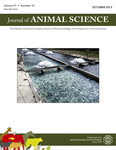-
Views
-
Cite
Cite
P. H. Hemsworth, M. Rice, J. Nash, K. Giri, K. L. Butler, A. J. Tilbrook, R. S. Morrison, Effects of group size and floor space allowance on grouped sows: Aggression, stress, skin injuries, and reproductive performance, Journal of Animal Science, Volume 91, Issue 10, October 2013, Pages 4953–4964, https://doi.org/10.2527/jas.2012-5807
Close - Share Icon Share
Abstract
A total of 3,120 sows, in 4 time replicates, were used to determine the effects of group size and floor space on sow welfare using behavioral, physiological, health, and fitness variables. Within 1 to 7 d postinsemination, sows were assigned randomly to treatments of a 3 by 6 factorial arrangement, with 3 group sizes (10, 30, or 80 sows/pen) and 6 floor space allowances (1.4, 1.8, 2.0, 2.2, 2.4, or 3.0 m2/sow). Sows were housed on partially slatted concrete floors, and overhead feeders delivered 4 times/day to provide a total of 2.5 kg of feed/sow. As pen space increased from 1.4 to 3.0 m2/sow, aggression at feeding decreased from about 9 to 7 bouts/sow (linear, P = 0.029) and plasma cortisol concentrations decreased from about 28 to 21 ng/mL (linear, P = 0.0089) at 2 d. Although the results are in accord with a linear decline from 1.4 to 3 m2/sow, the results are also in accord with a decline in these measurements from 1.4 to 1.8 m2/sow and no further decline greater than 1.8 m2/sow. Farrowing rate (percentage of inseminated sows that farrowed) also increased from about 60 to 75% as space increased from 1.4 to 3.0 m2/sow (linear, P = 0.012). Group size was related to skin injuries on d 9 (P = 0.0017), 23 (P = 0.0046), and 51 (P = 0.0006), with groups of 10 consistently having the lowest number of total injuries over this period. Based on the aggression and cortisol results, it is credible to judge that, within the range of floor space allowances studied, sow welfare improves with increased space. However, from a sow welfare perspective, the experiment had insufficient precision to determine what is an adequate space allowance for sows. Thus, although the results definitely support a space allowance of 1.4 m2/sow being too small, it is not possible to give guidance on an actual space allowance at mixing that is adequate.





